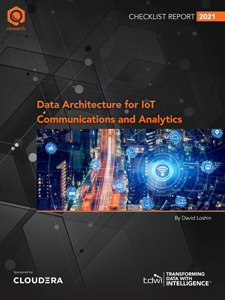
TDWI Checklist Report | Data Architecture for IoT Communications and Analytics
December 18, 2020
The foundation of a successful Internet of Things (IoT) implementation is a technical architecture that blends network connectivity with an information architecture for streaming, ingesting, filtering, and capturing data. This must be coupled with a means of analyzing the data, creating analytics models, and pushing those models back to the edge nodes in the IoT network.
Executing this vision demands organization and discipline when it comes to data management and oversight, requiring information models (including metadata and searchable services) for simplified integration. The environment must also integrate continuous monitoring to determine when objectives are being met or when there are opportunities for additional improvements.
Systemic objectives for IoT are less about the operation of any single device in the network and more about overall business performance optimization that can be achieved through visibility of all the devices and nodes in the network.
This checklist explores eight key suggestions for establishing an effective data architecture for an IoT environment.